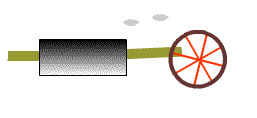Economics for Engineers
Work and Production
By Mark Ciotola
First published on April 17, 2021. Last updated on April 17, 2021.
Heat Engines and Work
Instead of placing a simple conductor between a hot and a cold reservoir, we can instead place a heat engine in between them.
A heat engine is a device that can use the flow of thermal energy to perform work. Such work can many things such include pumping water, compressing a spring, or running and electric generator. Below we see a hypothetical heat engine turning a wheel, such as to run a generator.

A heat engine will typically operate between hot and a cold reservoir as shown below. High temperature thermal energy will flow into the heat engine. A lesser amount of thermal energy will flow out of the hear reservoir.

The difference between thermal energy into and out of the heat engine is called work.
\( Q_{in} = Work + Q_{out}\)
Work and Productivity
Work is a form of physical productivity that may represent economic productivity as well. Physical work can used to produce electricity, manufactured goods and provide many services. Work is the useful products of physical and economic processes.
\(Production = Work \).
By the way, thermal energy removed from the hot reservoir \(Q_H\) is analogous to revenue (R). Thermal energy exhausted into the cold reservoir \(Q_C\) is analogous to cost (C).
Profits
Let’s imagine a firm that is analogous to a simple heat engine operating across a hot and a cold reservoir. For example, you buy and sell widgets. You receive cash (revenue) when you sell widgets and you pay cash (costs) when you sell widgets. Here, there are no overhead costs. It’s a simple business.
Then, Profit P would be:
\(W = Q_H – Q_C\), or,
\(P = Q_H – Q_C\), or,
\(P = R – C = Q_H – Q_c\).
« Supply and Demand | COURSE | Efficiency and Profit Margins »